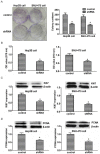KIFC1 promotes the proliferation of hepatocellular carcinoma in vitro and in vivo
- PMID: 31788047
- PMCID: PMC6865703
- DOI: 10.3892/ol.2019.10985
KIFC1 promotes the proliferation of hepatocellular carcinoma in vitro and in vivo
Retraction in
-
[Retracted] KIFC1 promotes the proliferation of hepatocellular carcinoma in vitro and in vivo.Oncol Lett. 2023 Jun 26;26(2):345. doi: 10.3892/ol.2023.13931. eCollection 2023 Aug. Oncol Lett. 2023. PMID: 37427345 Free PMC article.
Abstract
Hepatocellular carcinoma (HCC) is a common type of malignant tumor worldwide with a high mortality rate. In the past 20 years, the morbidity rate of HCC has increased. Progress has been made in the clinical diagnosis and therapy for HCC. However, due to the high heterogeneity and metastasis targeted therapy for HCC exhibits great promise, and novel therapeutic targets for HCC are urgently required. Kinesin family member C1 (KIFC1) is a member of the kinesin superfamily of proteins. Previous studies have indicated a potential association between KIFC1 and cancer progression. However, the potential role of KIFC1 in the development of HCC remains unclear. The present study aimed to explore the function of KIFC1 in HCC. Immunohistochemical (IHC) assays were performed to explore the KIF15 expression levels in 74 samples of HCC and corresponding non-tumor tissues. The potential association between KIF15 expression levels and clinical features was analyzed, and the effects of KIF15 on cell proliferation of HCC were detected by colony formation and MTT assays. In addition, the proliferation-related proteins Ki67 and PCNA were detected by western blotting. The possible effects of KIF15 on tumor growth were measured in mice. The results demonstrated that a high expression level of KIFC1 was associated with poor prognosis of HCC. Further results indicated that KIFC1 promoted cell proliferation of HCC in vitro. In addition, knockdown of KIFC1 suppressed tumor formation and growth in mice. Therefore, these results provide a potential therapeutic target for the treatment of HCC.
Keywords: hepatocellular carcinoma; kinesin family member C1; poor prognosis; proliferation; therapeutic target.
Copyright: © Wang et al.
Figures




Similar articles
-
KIFC1 is activated by TCF-4 and promotes hepatocellular carcinoma pathogenesis by regulating HMGA1 transcriptional activity.J Exp Clin Cancer Res. 2019 Jul 24;38(1):329. doi: 10.1186/s13046-019-1331-8. J Exp Clin Cancer Res. 2019. PMID: 31340839 Free PMC article.
-
KIFC1, a novel potential prognostic factor and therapeutic target in hepatocellular carcinoma.Int J Oncol. 2018 Jun;52(6):1912-1922. doi: 10.3892/ijo.2018.4348. Epub 2018 Mar 29. Int J Oncol. 2018. PMID: 29620256 Free PMC article.
-
Kinesin family member C1 accelerates bladder cancer cell proliferation and induces epithelial-mesenchymal transition via Akt/GSK3β signaling.Cancer Sci. 2019 Sep;110(9):2822-2833. doi: 10.1111/cas.14126. Epub 2019 Jul 23. Cancer Sci. 2019. PMID: 31278883 Free PMC article.
-
KIFC1 in cancer: Understanding its expression, regulation, and therapeutic potential.Exp Cell Res. 2025 Apr 1;447(1):114510. doi: 10.1016/j.yexcr.2025.114510. Epub 2025 Mar 8. Exp Cell Res. 2025. PMID: 40058447 Review.
-
Kinesin Family Member C1 (KIFC1/HSET): A Potential Actionable Biomarker of Early Stage Breast Tumorigenesis and Progression of High-Risk Lesions.J Pers Med. 2021 Dec 14;11(12):1361. doi: 10.3390/jpm11121361. J Pers Med. 2021. PMID: 34945833 Free PMC article. Review.
Cited by
-
Downregulation of KIF15 inhibits the tumorigenesis of non-small-cell lung cancer via inactivating Raf/MEK/ERK signaling.Histol Histopathol. 2022 Mar;37(3):269-285. doi: 10.14670/HH-18-408. Epub 2021 Dec 15. Histol Histopathol. 2022. PMID: 34908156
-
Novel oncogenes and tumor suppressor genes in hepatocellular carcinoma.Liver Res. 2021 Dec;5(4):195-203. doi: 10.1016/j.livres.2021.06.001. Epub 2021 Jun 23. Liver Res. 2021. PMID: 34900376 Free PMC article.
-
Hypoxia-induced LncRNA DACT3-AS1 upregulates PKM2 to promote metastasis in hepatocellular carcinoma through the HDAC2/FOXA3 pathway.Exp Mol Med. 2022 Jun;54(6):848-860. doi: 10.1038/s12276-022-00767-3. Epub 2022 Jun 28. Exp Mol Med. 2022. PMID: 35764883 Free PMC article.
-
Kinesin Family Member C1 (KIFC1) Regulated by Centrosome Protein E (CENPE) Promotes Proliferation, Migration, and Epithelial-Mesenchymal Transition of Ovarian Cancer.Med Sci Monit. 2020 Dec 28;26:e927869. doi: 10.12659/MSM.927869. Med Sci Monit. 2020. PMID: 33361741 Free PMC article.
-
Identification and Validation in a Novel Classification of Helicase Patterns for the Prediction of Tumor Proliferation and Prognosis.J Hepatocell Carcinoma. 2022 Aug 27;9:885-900. doi: 10.2147/JHC.S378175. eCollection 2022. J Hepatocell Carcinoma. 2022. PMID: 36061235 Free PMC article.
References
-
- Kim D, Li AA, Perumpail BJ, Gadiparthi C, Kim W, Cholankeril G, Glenn JS, Harrison SA, Younossi ZM, Ahmed A. Changing trends in etiology-based and ethnicity-based annual mortality rates of cirrhosis and hepatocellular carcinoma in the United States. Hepatology. 2019;69:1064–1074. doi: 10.1002/hep.30161. - DOI - PMC - PubMed
Publication types
LinkOut - more resources
Full Text Sources
Miscellaneous
